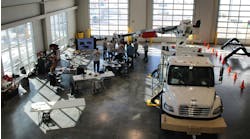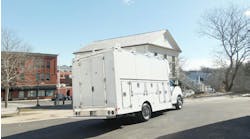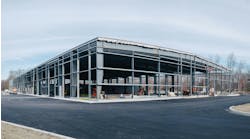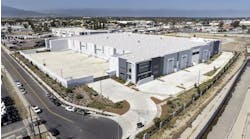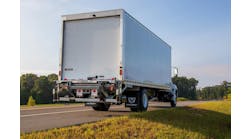Truck body builders and successful upfitters certainly should be well versed on the various tradeoffs involved in selecting the right design and materials for a service vehicle and the work it will do, but customers likely are not so aware of this often complex give and take.
So, among the numerous education sessions at this year’s Work Truck Show, a panel of engineers from industry leading companies explained the basics to a conference room full of fleet representatives. The presentation, “Vehicle Weight Reduction–Every Pound Counts,” also can serve as handy primer for those who need make sure their service body customers understand what’s involved when the topic is “lightweighting.”
The idea of lightweighting is basic enough, explained Stephen Anderson, principal engineer for Altec Industries–Body Business.
“It’s a concept in the auto industry about building cars and trucks that are less heavy as a way to achieve better fuel efficiency, increased payload and improve handling,” Anderson said, and he went on to provide an overview.
The specific benefits include:
• improved fuel efficiency, providing operational cost savings
• lower vehicle emissions, increasingly important in tightly regulated times
• increased legal payload, giving the end user the option to do more work with the same truck, or do the same work with a smaller, more efficient truck
• lower vehicle maintenance costs, because a lighter vehicle is less stressed
• advanced life cycle, again due to the lighter weight; and
• enhanced safety, also due to less stress.
Anderson then outlined the primary types of materials for bodies and their comparative strengths and weaknesses.
“The standard is pretty much steel,” he said. “We’ll get into a lot of benefits for that, and why we use steel for the primary bodies today. There are also fiberglass bodies, and there are aluminum bodies.”
Compared to steel, a fiberglass body is typically about 24% lighter, but the cost is 30% higher. An aluminum body is 28% lighter, and cost is 35% higher than steel.
The advantages to a steel body include
• durability
• distinct endurance limit to prevent fatigue failures
• configurable
• cost effective; and
• easy to repair.
But that strength comes at a cost: steel bodies are heavier.
The fiberglass body advantages include:
• lighter than steel
• durability; and
• fiberglass can be woven or laid to prevent fatigue failures.
But on the other hand fiberglass is:
• more costly than steel
• not very easy to configure (requires molds); and
• harder to repair.
Similarly, aluminum bodies have advantages such as being lighter than steel and configurable. “You can pretty much make an aluminum body identical to a steel body,” Anderson said. “You might want to say says why is it only 28% tighter, when a three pounds of steel equals about a pound of aluminum. But you have to upgauge that size of aluminum.”
Indeed, aluminum comes with several disadvantages:
• more costly than steel
• no distinct endurance limit to prevent fatigue failures, can crack over time
• softer than steel causing it to deform easier; and
• harder to repair.
“Now all of us do a lot of testing. So we make sure when we design a body out of aluminum, we are below that endurance limit for the life cycle of that body,” Anderson said. “But over time, and I mean years, they will tend to crack.
“We do a lot of things to prevent that fatigue and put the material thickness and the strength where it needs to be. So I would encourage you not to not use aluminum bodies because it could crack. We’ve designed aluminum bodies to prevent that cracking. But know that if you’re going to do a lot of rough roading and twisting in that body, aluminum may or may not be a good option for you.”
Details, details
Jon LeFaive, sales engineering manager for Dakota Bodies, got into some of the design specifics.
“’How much weight can I save?’ That’s the question we get asked when we’re called up,” LeFaive said. “And sometimes it’s in desperation: ‘I got this body and I’ve got to cut 500 pounds—what can I do?’ It’s kind of a loaded question.”
The answer, he continued, requires more questions “to drill down into the application of what they’re going to be using [that body] for.”
Indeed, LeFaive noted that after being invited to be on the panel he’s received “multiple requests” for weight studies.
“Some of the requests were a little concerning in how they were worded because, again, maybe there’s people in the industry that think that you can just do a direct swap and go straight to aluminum,” he said, and he held up a segment of 4-inch C-channel steel frame. “That’s not quite how it works.”
To illustrate, LeFaive showed a series of slides that diagrammed a 4-inch C channel and compared the properties of such a channel made with ASTM A36 steel and 6061-T6 aluminum. According to the calculations, while aluminum as a slight edge in yield strength and 66% weight savings, steel has a nearly 3-to-1 advantage in elasticity, or stiffness.
“As Steve said, we need to design for fatigue, which aluminum is much more susceptible to,” he added. “And so that’s why you can just swap out material for material.
“If you’re just building something for your garage or something like that, where you’re going to stick something on the shelf, resting paint cans on it or whatever, you can get quite a bit of weight savings. But once you start driving that down the road and having dynamic cycling on it, that’s when the fatigue issues come up.”
Similarly, in an example of 4-inch beam loaded to 1,500 pounds, the deflection for an aluminum beam was about three times that of steel, and even increasing the aluminum gauge doesn’t overcome steel’s strength advantage.
But, as LeFaive demonstrated, increasing the beam to 6 inches matches the deflection level of the 4-inch steel beam—and at a 47% weight savings. That savings figure, however, came with an asterisk.
“We just loaded that statically—we haven’t driven it down the road, it hasn’t gone through the fields in the ditches,” he continued. “That’s where the rest of our difference is made up. We’re at 47% here, but then we have to do the cycle testing. That’s what drives that weight difference from the 66% to the 47% on to about 30%.
“So if you just had a spitball an answer to somebody, they’ve got a 2,000 pound body, ‘how much can I save?’ that 28-30% is the number if we have to give a customer a five second answer.”
In giving other examples of lightweighting, LeFaive uses as 5,000 pound steel line body: Swapping the steel storage area doors for aluminum would save more than 250 pounds, while making the boxes out of aluminum would save more than 400 additional pounds.
“We haven’t touched the body yet, no structure—all we’ve done is changed some of the accessories and we’re all already over 650 pounds [in weight saving],” he said, pointing out that another 300 pounds could saved on cabinets and drawers. “All in all, we’ve gone from a 5,000 pound body down to about 4,000 pound body, and we haven’t touched the body yet. We just lightweighted accessories. So that’s one way of lightweighting if you don’t want to change your body to a different material today.”
LeFaive illustrated similar savings for a body with an aerial device. If the body is going on a truck with a lower capacity, there’s no need for it to built to spec for a higher-capacity vehicle.
Real world
Justin Steele, manager, specialty products engineering, for the Knapheide Manufacturing Company, concluded the presentation with a case study demonstrating the many benefits of using lightweighting to increase payload.
Using a 2018 Ram 4500 4X4 diesel, the aluminum upfit came in at 9,645 pounds compared to the steel upfit at 10,289 pounds.
“So that’s 640 pounds worth of tools, spare parts, gear, whatever that person needs to carry that they can carry with them, or that’s also 600 pounds of savings on your fuel bill,” Steele said.
But DOT Federal Motor Vehicle Safety Standards (FMVSS) now come into play as well, he emphasized. A vehicle weighing more than 10,000 pounds is subject to a much greater number of these regulations, and it also has more stringent OEM certification requirements:
• DOT numbers and Company Name
• Driver over 21 years of age
• Driver DOT physical and medical card
• DOT safety and emergency equipment
• Annual inspection of vehicle / trailer; and
• Maintain a driver qualification file for every driver.
“So with lower GVW chassis, there’s some real gains here with chassis availability, more flexibility, as far as those go, more options,” Steele said. “There’s also reduced cost of ownership for the life that vehicle, ease of resale—it’s a lot easier to find a buyer for a half-ton truck than a 4500 truck—and reduced initial chassis cost.”
Steele then detailed several examples of the advantages of smaller chassis with aluminum upfits, with the general conclusion that slight decreases in payload and higher initial costs are ultimately offset by other operational and TCO advantages.
“So in summary, the good news and bad news is there are a lot options for lightweighting for a fleet,” Steele said. “It’s not one size fits all. Aluminum, fiberglass, composite materials, whole bodies, partial bodies, boxes: You can take this a lot of different ways as an end user or a spec writer.
“Be in touch with your body builders, your dealers, your distributors; they can help you with those options. Different markets are going to have different needs, and an all-aluminum body might not be the right fit for every customer. An all-fiberglass body might not be the right fit, but there are applications where it makes a lot of sense. The industry is trending towards smaller vehicles, more fuel-efficient vehicles, less greenhouse gas emissions. So people are looking for ways to do the same job with less weight of the vehicle, and take advantage of that.”
